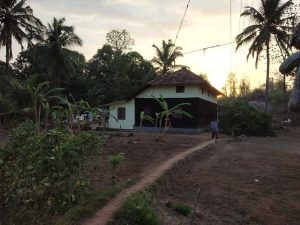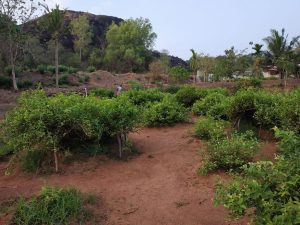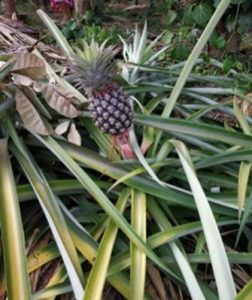People of Bharat: Selly Maushi, Udupi

I walk down a narrow dirt road, lined with trees on both sides. The road bends towards the left and I find her — a middle-aged woman; hose in hand, watering a small grove of betel nut trees. I notice pepper vines are clinging to each betel tree; and pineapple plants border the boundary of the grove. She smiles at me and I wave back; I signal asking if I can come closer. She beckons me in as I find my way through the thorny pineapple plants, careful to avoid the large, red ants native to this region. I ask her if she speaks Konkani. She nods and enquires about ‘whose daughter I am.’ I explain to her I am not related and just visiting. She asks me if I know anyone in the village and I name one of my close relatives. That does it — I win her trust and she invites me into her house. And this is how I find Selly *maushi.

Selly maushi is 53 years old and lives in a small village at the periphery of Udupi district in Karnataka. She lives with her husband and daughter in a village-style farmhouse. The house is near the village well and has a large living room, small bedrooms and an attached cow-shed. While the walls are concrete, the roof is sloping; laid with terracotta tiles, typical to this region. There is a verandah and an open area at the entrance. A green, grooved pipe leads from the well to the fields-evidence of an electric pump. The house is clean, well ordered and sports a few electric appliances such as TV, fridge and electric fans. I notice a young girl sitting on a bench by the window in the living room ruffling the pages of a book. I learn that she is Selly’s younger daughter. Watching me sit to take notes, she closes her book and sits beside me. ‘We have wi-fi too in case I want to log in’ she says. A showcase on the wall in the hall holds family pictures. I peer at a picture of an adolescent girl holding a baby. ‘There’s a gap of 12 years between the two of them’ clarifies Selly with a smile. I learn Selly’s elder daughter is married and works in Kuwait as a nurse. Her younger daughter has recently enrolled in a management college in Bengaluru and will start classes in a month. Selly and her husband have both completed primary education. Selly maushi tells me that their house is her husband’s ancestral home where she moved in at the age of 19. Over the years they have owned a fridge, TV and an electric pump. They also own a scooter and a motorbike. The scooter is used by her daughter during weekends; her husband uses the motorbike for daily errands.

Selly maushi’s family owns two acres of land and she invites me for a walk across her fields. She leads me through the coconut grove, and a few rice fields.

She explains that they grow a variety of crops such as coconuts, betel nut, pineapples, pepper, cashew nuts and jasmine. As we reach a patch of maize, Selly maushi plucks an ear of corn and hands it to me. Seeing her reach out for the second one, I plead with her not to break anymore; ‘You could sell this!’ I exclaim. Selly laughs; ‘We grow maize only for the cows. We don’t sell it.’ She leads me towards the large vegetables patch and shows me the variety of vegetables being grown such as the lady’s finger, ash gourd, beans, chillies and Malabar spinach.
Coming back to the conversation her husband speaks about his employment in the ‘Gulf’. He worked there as a cook, sending part of his earnings back home. In the year 1998, his employer sent him back, leaving him nothing to go back home with. He returned to depend entirely on farming as the family’s main source of income.
We return to the house and are soon joined by her husband. Now I had the couple together, trying to tell me about their farm, the daily life and their income. Seeing them struggle calculating their monthly income and expenses, I ask them to just state their seasonal income from various crops. This is easier to them. Coconuts earn them about Rs. 45,000 per year, another Rs. 50–60,000 per annum from pepper and betel nut, and about Rs. 75,000 from vegetables. ‘Tender coconuts sell for Rs. 15 each and a dried coconut kernel for Rs. 25’ Maushi adds. She tells me they got a good rate for lady’s finger this year — ‘Rs. 50 per kilo!’ They produce between 5 to 10 kilos per day in a good season (a season lasts for about two to three months.) They also produce about 900 kilos of rice each year, selling it for Rs. 15 per kilo. Jasmine flowers are their most regular source of farm income, fetching them almost about Rs. 10,000 every week in peak season and Rs. 1200 when the demand is low. They also harvest about 100 to 120 pineapples each year; each fruit fetches them Rs. 100–150 depending on its weight.
They also own a few chickens and three cows. “What about the dog?” I inquire as I see a canine chained at the window; obviously taken for granted. ‘Every house here has a dog. We need them to scare away strangers… Sometimes at night, leopards come down from the hills. We lost our older dog to a leopard last year” she adds, regretfully.
Intrigued by the cows, I enquire about how much the cows earn them. She says that they only rear the cows. They buy a small calf anywhere below Rs. 6000 to Rs. 10,000 and then raise it for a year. When it gets pregnant, they sell it to a broker for Rs. 25,000. The broker tows the cattle to an animal fair in Shivamogga district where it is then sold at auction. ‘Not everyone can do this business. The brokers ask for our identity and Aadhar cards. They don’t do business without these proofs.’ Every morning Selly feeds the cows green stalks of maize which have been freshly cut the previous day. She shows me the cow-shed; lined with dry leaves. She then takes the animals into the fields to graze. The cows are brought in around late afternoon, cleaned and then fed straw. Selly rakes out the leaves everyday along with the cow dung and collects it in a large woven basket. I tell her that it’s a lot of work for a lean profit. ‘Even so,’ says she; ‘we need the cows; we use their dung as manure for our plants.’
Starting early every day the family wakes up at 5 AM to finish few tasks before noon. They first head to the jasmine fields, water the bushes and harvest the flowers. Heading back home with the flowers they sit down to make garlands. These are then wrapped in a banana leaf and left at the gate of the house — ready for the agent who comes to collect them. They then harvest vegetables and tend to the plants. ‘We have to water them every day and put manure on a regular basis. We have to feed the cows and take them into the fields to graze. We also need to feed the dog and chickens. By the time we finish with these, it’s already noon.’
I enquire about the household expenses to which she says, “amso kharas mostu une asa. Kalein kartat tein jevcheam” (we spend very little and eat what we grow.) They roughly spend about Rs. 10–15,000 every month mainly towards electricity, gas and groceries such as spices, tea, sugar and oil. They buy locally caught fish sold by a local fish-vendor and consume meat only on special occasions. During the coconut harvest season, they spend on labour charges. Selly elaborates, ‘A man from the nearby village charges Rs. 50 to climb one tree. Whether there are ten coconuts or 50, the charge remains the same. So we get this done only one time.’ (My estimate tells me they have about 20–30 trees growing in the farm.) The family does all other manual labour required on the farm by themselves. She has seen some of the wealthier villagers employing migrants from Orissa in their fields for about Rs. 3000 a month but shares the difficulty finding labour. ‘I cannot understand why they come all the way here (to Karnataka) for such a pittance!’ she reflects. In a softer voice, Selly mentions that they will spend Rs. 4 lakhs over the next two years on their daughter’s college fees, the admission fees has been paid.
Selly maushi talks about being an active member of her Church community. She saves in a joint member account held by 10 members; each month every member saves Rs. 100. They have 16 such groups in the area in the name of their religious head and the bank gives them a loan if any member needs it. Selly maushi owns a joint bank account with her husband in a farmer cooperative branch and usually saves in fixed deposits. A year ago, they had taken a loan of Rs. 1 thousand from the cooperative bank for planting new jasmine bushes at 0% interest. ‘Usually, borrowers need to repay the loan within a year or pay double the amount as fine!’ But the loan was waived off till the amount of Rs. 1 lakh under a government scheme for drought affected areas. ‘We had taken a loan of Rs. 1 lakh 4 thousand and we had to repay only Rs. 4000,’ Selly smiles.
I point at a vegetable basket on the verandah. ‘Is this today’s harvest for sale?’ I ask. ‘No, not for sale,’ she explains. ‘Tomorrow is the inauguration of a new temple in the area. Our religious head has asked us all to take some vegetables as our contribution towards the event. The temple will be feeding a lot of visitors free of charge for one week. Everyone is invited, irrespective of religion.’
Leaving me with a final thought, she shares that the couple has just one financial aspiration. They want to save and invest towards their daughter’s education. Her wedding expenses do not worry them. ‘She will have to earn and manage some of those expenses. The main thing is to get her educated. Once she can stand on her feet, both of us will need very little to live,’ Selly leans back.
maushi — aunt, in Konkani
This research was developed as part of the Bharat Inclusion Initiative.
